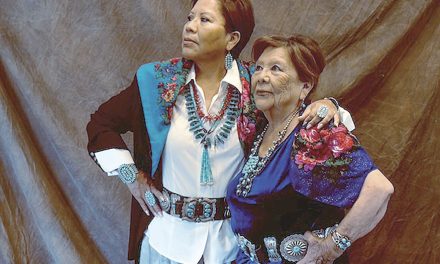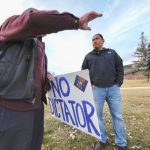
Reporter’s Notebook | ARPA: Pay the people their fair share
Isn’t it time the people get their fair share of the ARPA pie?
If you divide the $2.1 billion in American Rescue Plan Act funds given to the Navajo Nation by an estimated 400,000 Diné tribal members, that figure amounts to $5,198 per person.
The bulk of those funds were allocated by the U.S. Treasury based on Navajo tribal enrollment data.
It’s the people’s money. So, doesn’t every Diné have a right to a portion of it?
How hard would it have been for the Navajo Nation government to allocate at least 1/5 of the ARPA funds, or about a $1,000 per person, to Hardship Assistance when the money came in last May? That money could have alleviated suffering and helped people prepare for the winter.
ARPA was enacted precisely to provide relief and help people recover from the impacts of the pandemic that are still ongoing, including financial hardship.
Despite the efforts of a few delegates, including Delegate Eugenia Charles-Newton and Vince James, to prioritize Hardship Assistance in June, the Navajo government failed to deliver that to the people in 2021.
This failure has left many Diné feeling sidelined, overlooked and uncared for at a time when the virus has already taken an emotional toll.
Leadership chose to focus on “projects over people” instead of finding a balance between the two early on.
It took the executive branch, led by the president’s office, seven months after receiving the ARPA funds to finally share details of its proposed expenditure plan, which does include $207 million for Hardship, but that is tied to a huge infrastructure bill (No. 257-21), which is now stalled.
One can’t help but wonder if that was a deliberate strategy by the bill’s authors to provide an incentive for delegates to pass the $1.16 billion dollar projects bill, because they know the people need assistance.
In passing the first ARPA bill (No. CJY-41-21) in July, which created a framework for spending the funds, the Navajo Nation Council also chose to limit Hardship Assistance to 10% of the ARPA funds, which amounts to roughly $600 per person.
The contents of the bill were largely steered by the president’s office in conjunction with sponsor Speaker Seth Damon.
Unfortunately, by voting for it, delegates tied their hands with the 10% Hardship cap in terms of flexibility to make bigger payments as needed.
By passing the resolution, the Council also turned administrative oversight of ARPA funds to the president’s office by appropriating 10% of the ARPA monies, $207 million, to the OPVP and the speaker’s office (90%/10% formula) to manage and administer ARPA projects and services.
That was a pivotal moment for all to witness when the government awarded itself $207 million but didn’t immediately appropriate $207 million in Hardship funds for the people.
August would have been the perfect time to do so and could have guaranteed a first round of $600 hardship assistance payments by year’s end.
At least if they had done both, Navajo Nation leaders would have engaged the goodwill and gratitude of the people instead of alienating them.
While some leaders may have been hoping for a return to pre-pandemic “normal” in 2021, that is not what happened. And they have also left the Nation largely unprepared to deal with the COVID-19 public health response.
For example, the Navajo Department of Health is underfunded and while its focus on vaccination roll-out has been admirable, it now lacks the resources to ensure a comprehensive COVID-19 response amid another national surge.
Its leader, Jill Jim, has in recent public forums advised people to prepare on their own to isolate if they are infected with COVID because none of the former NDOH quarantine services, i.e., hotels or alternate care sites are available because of lack of funding and foresight.
Despite a few months of reprieve in COVID-19 cases last spring/summer following a deadly winter surge, our psyches have been bombarded with a list of new concerns, from more contagious and infectious variants to waning vaccination immunity to the emergence of breakthrough infections.
One would think that government leaders would have taken that as a cue to focus on ramping up its own COVID-19 response (in addition to vaccines), using ARPA funds, as a precautionary measure.
Even before 2021 arrived, many people still had not even recovered from the toll that 2020 took, whether from having COVID-19, losing loved ones to the virus or suffering from the isolation and restrictions of lockdowns.
While the “stay-at-home” orders did serve to keep people safe and bring some family members closer together, others did not fare so well and found themselves separated from their loved ones.
Some elders became even more isolated amid the restrictions, including those in nursing homes who were not allowed visitors because of the virus.
People have also suffered pandemic related job losses, increases in their utility bills, trouble keeping their children engaged in online schooling, losing their homes due to reduced income, and limited mobility due to COVID-19 restrictions.
Others may still be experiencing food insecurity, lack of adequate heating or dealing with long COVID during this harsh winter.
All of this has caused a great deal of stress and anxiety for many people, and leadership has certainly heard about this from their constituents.
While funding infrastructure projects such as water, waste water, electricity and broadband are no doubt critically important to the future of the Nation and its people, there was a way to roll out these projects in balance with addressing the immediate hardship that people are experiencing.
Additionally, a point that is rarely made is that infrastructure projects simply will not benefit all the Navajo people.
One of the problems with the infrastructure bill is that it cannot possibly address all of the infrastructure needs on Navajo.
As estimated by the president’s office, the total funding needed for about 10,000 projects identified on the Navajo Nation is $18.7 billion.
That is part of the reason the bill stalled, because delegates will, of course, need to advocate for projects in their districts, which is going to lead to a prolonged battle in finalizing it and making sure it is equitable.
In the meantime, appropriating Hardship Assistance for everyone would send the message that every Diné matters.
Now Delegate Amber Kanazbah Crotty has dropped emergency legislation that separates the $207 million Hardship piece from the president’s office’s infrastructure bill so that ARPA money can get out to the people sooner.
Hopefully, the Council and the president will embrace Crotty’s standalone bill, remove the 10% cap on Hardship and pay the people the Hardship Assistance they deserve in early 2022.
Hopefully, they will also immediately reprioritize a portion of ARPA funds for a more robust public health COVID-19 response.
The fact that we are once again in a sea of uncertainty with the emergence of the Omicron variant demonstrates just how vulnerable we still are to COVID-19.
Who knows what the future holds, or how the efficacy of vaccines will hold up to more transmissible and/or infectious variants over time?
For now, leaders must accept the fact that we must live with COVID-19, adapt to the uncertainties, stay flexible and take quick action to address them.
It’s time to prioritize the people, give them resources they need, and prepare for the future as the virus continues to ebb and flow.








 Highway 264,
Highway 264, I-40, WB @ Winslow
I-40, WB @ Winslow